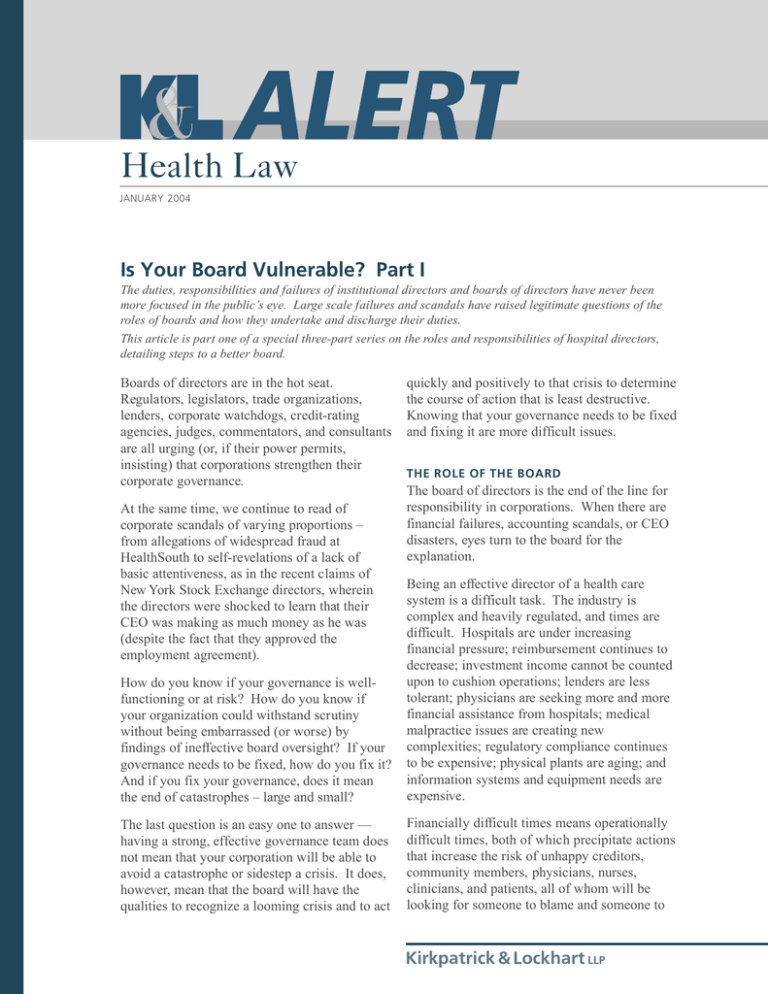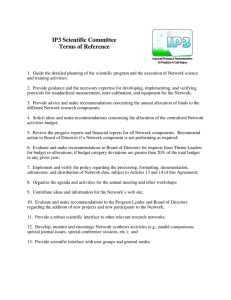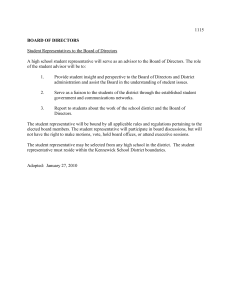
Health Law
JANUARY 2004
.Is
Your Board Vulnerable? Part I
The duties, responsibilities and failures of institutional directors and boards of directors have never been
more focused in the public’s eye. Large scale failures and scandals have raised legitimate questions of the
roles of boards and how they undertake and discharge their duties.
This article is part one of a special three-part series on the roles and responsibilities of hospital directors,
detailing steps to a better board.
Boards of directors are in the hot seat.
Regulators, legislators, trade organizations,
lenders, corporate watchdogs, credit-rating
agencies, judges, commentators, and consultants
are all urging (or, if their power permits,
insisting) that corporations strengthen their
corporate governance.
At the same time, we continue to read of
corporate scandals of varying proportions –
from allegations of widespread fraud at
HealthSouth to self-revelations of a lack of
basic attentiveness, as in the recent claims of
New York Stock Exchange directors, wherein
the directors were shocked to learn that their
CEO was making as much money as he was
(despite the fact that they approved the
employment agreement).
quickly and positively to that crisis to determine
the course of action that is least destructive.
Knowing that your governance needs to be fixed
and fixing it are more difficult issues.
THE ROLE OF THE BOARD
The board of directors is the end of the line for
responsibility in corporations. When there are
financial failures, accounting scandals, or CEO
disasters, eyes turn to the board for the
explanation.
How do you know if your governance is wellfunctioning or at risk? How do you know if
your organization could withstand scrutiny
without being embarrassed (or worse) by
findings of ineffective board oversight? If your
governance needs to be fixed, how do you fix it?
And if you fix your governance, does it mean
the end of catastrophes – large and small?
Being an effective director of a health care
system is a difficult task. The industry is
complex and heavily regulated, and times are
difficult. Hospitals are under increasing
financial pressure; reimbursement continues to
decrease; investment income cannot be counted
upon to cushion operations; lenders are less
tolerant; physicians are seeking more and more
financial assistance from hospitals; medical
malpractice issues are creating new
complexities; regulatory compliance continues
to be expensive; physical plants are aging; and
information systems and equipment needs are
expensive.
The last question is an easy one to answer —
having a strong, effective governance team does
not mean that your corporation will be able to
avoid a catastrophe or sidestep a crisis. It does,
however, mean that the board will have the
qualities to recognize a looming crisis and to act
Financially difficult times means operationally
difficult times, both of which precipitate actions
that increase the risk of unhappy creditors,
community members, physicians, nurses,
clinicians, and patients, all of whom will be
looking for someone to blame and someone to
Kirkpatrick & Lockhart LLP
make them economically and emotionally whole.
Undertaking cost-cutting measures; retaining turnaround specialists; closing services or programs or
hospitals; and entering into affiliation agreements
or sales agreements could all result in dramatic
negative consequences if things go wrong.
A director is a fiduciary. Every person who has
an interest in the health system – its employees,
its patients, its vendors, its physicians, its
lenders, its donors – is placing its, his, or her
trust in the board to do the right thing. Doing
the right thing does not mean that people won’t
be hurt. Doing the right thing means that the
board’s action is defensible – that the directors
believed, in good faith and after reasonable
diligence, the action to be the best solution
given the constraints that the organization faced.
e
STEP ONE OF SIX –
Educate
A health system is a complicated organization.
Understanding all of the moving parts of a hospital
is a difficult task and not intuitive. Management
and senior board members need to help new
directors understand the business and the mission.
■
Provide a practical orientation program that
highlights the system’s structure, its
corporations, its boards, and its services, as
well as explaining the service area
demographics (What population do you serve?
What medical needs do they have?),
competition, and unmet medical needs.
■
Provide a binder to each director with the
corporate organizational chart, board structure
and committees, bylaws, and key statistics –
number of admissions, key services, service
area. It is important to have this information in
writing (updated annually) so that directors can
refer to it.
■
Tour the hospital facilities, showcase its
programs and services. A board cannot make
accurate decisions without being able to place
its organization in context.
BUILDING A BETTER BOARD &
BEING A BETTER DIRECTOR
How do you get that secure feeling that, as a
fiduciary, you did not breach the trust that was
placed in you? Having good intentions, not
meaning to do anything wrong, and believing that
the selected course of action was the best one is
not good enough. The problem generally (absent
fraud) is not that directors did not believe their
action was the best solution. The problem is being
able to demonstrate that the board (1) understood
the problem, (2) understood the options, and
(3) reliance upon the board’s committees,
consultants, and senior management’s advice was
warranted. A director needs to know enough to
ask questions, to raise issues, and to not be 100%
dependent on management’s position. But how?
Being effective comes down to three basic
concepts:
■
knowledge
■
faithfulness to your duty
■
well-founded trust
The law protects directors who make decisions
that may end up, in retrospect, to have been wrong
or that have financially disastrous consequences,
as long as the board made the decision with pure
motives and after investigating and examining the
risks and benefits of each option.
Over a series of three articles, we have outlined
six steps to a better board – each of which ties
back to knowledge, faithfulness, or trust.
2
Board education should not end with orientation.
Speakers from within and outside of your
organization each can offer valuable perspectives on
issues such as strategic trends, financial
performance, quality indicators, programs, and
services.
Listening to the CEO talk about a new service or
the impact of a program on a community cannot
compare to visiting the facility and talking with
employees who work in the program and the
patients who utilize the program. Board meetings
do not need to be held in the hospital board room –
take them on the road so that directors can see first
hand the facilities and the communities served by
the health system.
Document the education you provide (including site
visits and tours). The primary benefit of education
is that it enhances the board’s ability to make
decisions. A secondary benefit is that it
demonstrates that directors have a solid foundation
for making logical, educated decisions,
undercutting the veracity of any allegations of
negligence or mismanagement.
KIRKPATRICK & LOCKHART LLP HEALTH LAW ALERT
ACTION ITEMS:
1. Review and update your orientation program,
incorporating feedback from directors who
have been through the program.
2. Have an incumbent director sit through or at
least review the orientation program and ask
that director whether he/she believes the
orientation program is useful.
3. Management, along with a committee of the
board, should design a year-long education
program, including internal and external
speakers on a variety of topics, such as health
system trends, financial indicators,
accreditation standards, quality trends,
insurance, risk management, and pension.
These programs do not need to be Broadway
productions in order to be meaningful. For
example, at insurance renewal time, have your
broker explain policy coverages, comparison
with peer systems, insurance trends, and
recommendations. At the end of the year,
have the board evaluate the presentations and
make suggestions for the upcoming year.
4. Tour hospital facilities from time to time.
5. When planning to undertake a significant
decision (for example, to affiliate with
another system), in addition to having
presentations from your consultants
regarding the specific proposal at issue,
have speakers from other systems that have
elected to affiliate and those who have
considered the issue but declined to affiliate
to offer some perspective to your board
(either directly through a presentation or in
a more informal setting by meeting with
several directors).
6. Allow sufficient time in your board meetings
for meaningful discussion and encourage
questions. Schedule some informal board
time as well (maybe during the pre-meeting
breakfast or dinner) that allows directors to
talk among themselves, with hospital
management, and with presenters.
7. Document, document, document so that you
have evidence that the board had a solid basis
for its decision-making. Directors are
protected in their decision if it was
JANUARY 2004
(1) undertaken in good faith, (2) made in the
best interest of the corporation, and (3) made
with due care, inquiry and investigation.
Directors, when they are deposed or otherwise
questioned, may not recall all of the
information and options they considered when
they made a decision. You need to keep a
record and the documentation should be kept
with board minutes so that it is easily
accessible in one place.
STEP TWO OF SIX –
Disseminate Information
So It Informs
Directors finding themselves as defendants in
D&O-based suits are often faced with having to
say that they did not know disaster was lurking
around the corner. But weren’t financials
provided every month? Well, yes. Didn’t the
CFO provide a financial report? Well, yes.
Didn’t the external auditors present the final
audit to the board? Well, yes. But you still
didn’t know? Well, no.
One problem in these instances (and not really
solvable except by getting rid of the culprits) is
fraud – auditors may have been intentionally
misled, giving the board assurances that were
simply inaccurate. The more common problem,
however, (which is solvable) is that information
is often not conveyed in a meaningful way to
board members so that their attention is called
to significant items or trends.
Some directors report that they are buried in an
avalanche of documents each month (often
delivered the day before the board meeting).
Just wading through the stack of papers and
identifying what is there is difficult enough.
Understanding them and putting them into
context, especially when the operations are
divided among multiple corporations, is a huge
undertaking, made even more onerous if
members of management are not highlighting
items of concern. The important material gets
lost in the sheer volume of information.
Financial reporting for health care systems is
complex. It is unrealistic to think that every
member of the board will have an intimate
Kirkpatrick & Lockhart LLP
working knowledge of the financials. That’s
okay as long as:
(a) you have a finance/audit committee that is
primarily responsible for understanding and
conveying to the rest of the board the key
information on the financials;
(b) your finance/audit committee is composed
of members with financial expertise – who
are able to converse knowledgeably with the
auditors and who have a direct relationship
with the auditors (not monitored and
managed by management); and
(c) your external auditors are auditors only and
do not have significant consulting
assignments that could create a conflict of
interest or tie the auditing firm’s loyalties
too closely to management. (The second
article in this series of articles discusses
these issues in more depth).
With the assistance of your external auditors,
select several financial indicators for the full
board to track rather than reviewing financial
statements in a vacuum. For example, looking
at your organization’s liquidity ratios, days of
cash on hand, or debt service ratios and
comparing them against recommended
standards and peer hospitals on a monthly basis
helps to put your organization’s performance in
perspective. Every board member need not be
an expert, but every board member should have
a working knowledge of the organization’s
financial picture and be able to eyeball changes
and ask questions based on those changes.
The concept of “targeted reporting” can be used
for areas other than financial reporting. For
example, while the quality committee may
review all of the information, the board could
have reporting on several quality indicators that
it has selected at the beginning of the year, with
a summary report on the rest so that the board
can see outliers easily, but is not inundated with
raw data or overwhelmed with reporting.
ACTION ITEMS:
1. Develop a financial reporting mechanism
that is easy for the board to use, identifies
all of the key information, and is used in
conjunction with a management report
highlighting issues of note.
2. With your external auditors, identify
financial indicators for the board to track on
a monthly basis, providing historical data
and peer data for comparison purposes.
3. Ask your directors how user-friendly and
informative your reporting mechanisms are
and update if necessary. The key is to
provide information in a manner that every
board member is able to understand and
convey back the relevance of the
information provided.
JUDY J. HLAFCSAK
jhlafcsak@kl.com
412.355.8920
FOR MORE INFORMATION, please contact one of the following K&L lawyers:
Boston
R. Bruce Allensworth
Edward J. Brennan, Jr.
ballensworth@kl.com
ebrennan@kl.com
617.261.3119
617.951.9143
Harrisburg
Ruth E. Granfors
Raymond P. Pepe
rgranfors@kl.com
rpepe@kl.com
717.231.5835
717.231.5988
Miami
Marc H. Auerbach
William J. Spratt, Jr.
mauerbach@kl.com
wspratt@kl.com
305.539.3304
305.539.3320
Newark
Stephen A. Timoni
stimoni@kl.com
973.848.4020
Pittsburgh
Judy J. Hlafcsak
Edward V. Weisgerber
jhlafcsak@kl.com
eweisgerber@kl.com
412.355.8920
412.355.8980
aberkeley@kl.com
202.778.9050
Washington Alan J. Berkeley
®
Kirkpatrick & Lockhart LLP
Challenge us. ®
www.kl.com
BOSTON
■
DALLAS
■
HARRISBURG
■
LOS ANGELES
■
MIAMI
■
NEWARK
■
NEW YORK
■
PITTSBURGH
■
SAN FRANCISCO
■
WASHINGTON
.........................................................................................................................................................
This bulletin is for informational purposes and does not contain or convey legal advice. The information herein
should not be used or relied upon in regard to any particular facts or circumstances without first consulting a lawyer.
4
© 2004 KIRKPATRICK & LOCKHART LLP.
ALL RIGHTS RESERVED.
KIRKPATRICK & LOCKHART LLP HEALTH LAW ALERT




